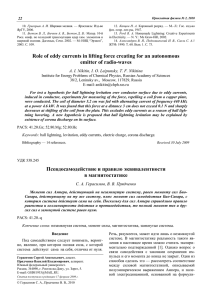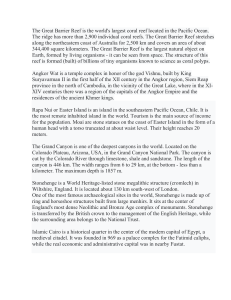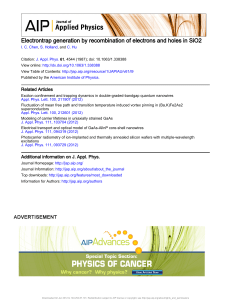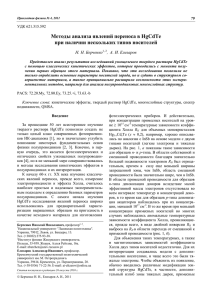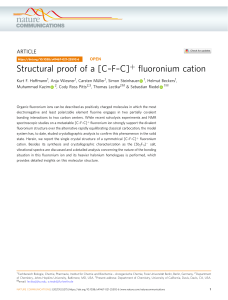Fabrication and characteristics of lateral Ti-4H-SiC Schottky barrier diodes
реклама
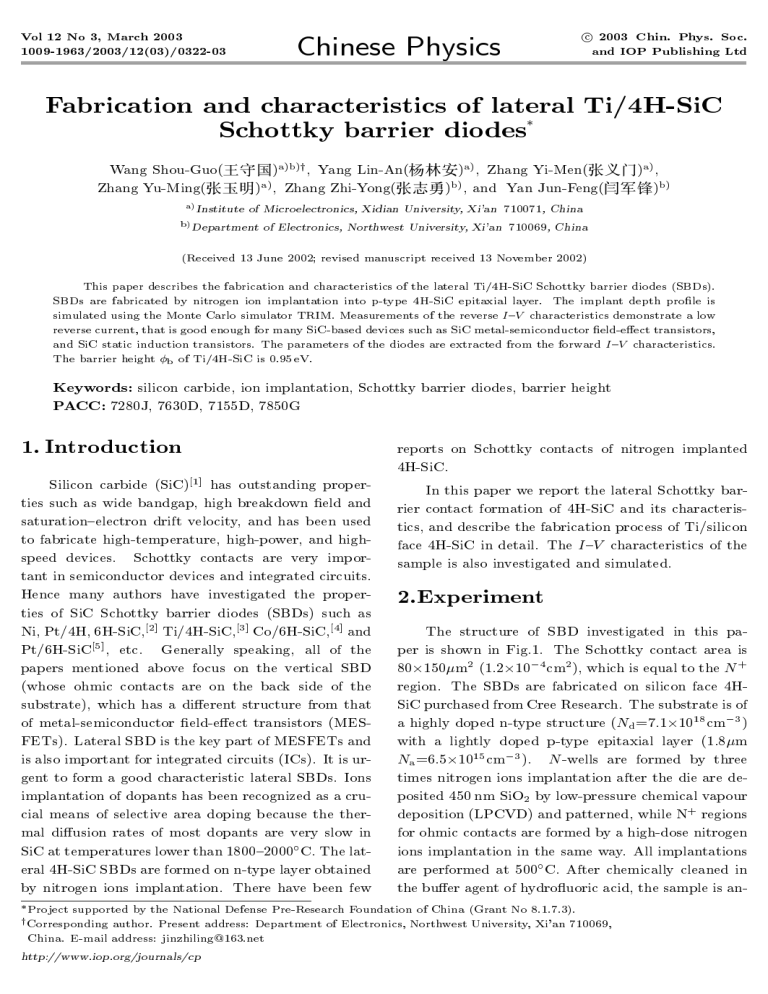
Vol 12 No 3, March 2003
1009-1963/2003/12(03)/0322-03
Chinese Physics
c
2003 Chin. Phys. Soc.
and IOP Publishing Ltd
Fabrication and characteristics of lateral Ti/4H-SiC
Schottky barrier diodes*
Wang Shou-Guo(¨§¢)a)b)y , Yang Lin-An(©¤ )a) , Zhang Yi-Men(­ª¥)a) ,
Zhang Yu-Ming(­¬¦)a) , Zhang Zhi-Yong(­Æ«)b) , and Yan Jun-Feng(¯£¡)b)
a) Institute of Microelectronics, Xidian University, Xi'an
b) Department of Electronics, Northwest University, Xi'an
710071, China
710069, China
(Received 13 June 2002; revised manuscript received 13 November 2002)
This paper describes the fabrication and characteristics of the lateral Ti/4H-SiC Schottky barrier diodes (SBDs).
SBDs are fabricated by nitrogen ion implantation into p-type 4H-SiC epitaxial layer. The implant depth pro le is
simulated using the Monte Carlo simulator TRIM. Measurements of the reverse I {V characteristics demonstrate a low
reverse current, that is good enough for many SiC-based devices such as SiC metal-semiconductor eld-e ect transistors,
and SiC static induction transistors. The parameters of the diodes are extracted from the forward I {V characteristics.
The barrier height b of Ti/4H-SiC is 0.95 eV.
silicon carbide, ion implantation, Schottky barrier diodes, barrier height
PACC: 7280J, 7630D, 7155D, 7850G
Keywords:
1. Introduction
Silicon carbide (SiC)[1] has outstanding properties such as wide bandgap, high breakdown eld and
saturation{electron drift velocity, and has been used
to fabricate high-temperature, high-power, and highspeed devices. Schottky contacts are very important in semiconductor devices and integrated circuits.
Hence many authors have investigated the properties of SiC Schottky barrier diodes (SBDs) such as
Ni, Pt/4H, 6H-SiC,[2] Ti/4H-SiC,[3] Co/6H-SiC,[4] and
Pt/6H-SiC[5] , etc. Generally speaking, all of the
papers mentioned above focus on the vertical SBD
(whose ohmic contacts are on the back side of the
substrate), which has a di erent structure from that
of metal-semiconductor eld-e ect transistors (MESFETs). Lateral SBD is the key part of MESFETs and
is also important for integrated circuits (ICs). It is urgent to form a good characteristic lateral SBDs. Ions
implantation of dopants has been recognized as a crucial means of selective area doping because the thermal di usion rates of most dopants are very slow in
SiC at temperatures lower than 1800{2000Æ C. The lateral 4H-SiC SBDs are formed on n-type layer obtained
by nitrogen ions implantation. There have been few
reports on Schottky contacts of nitrogen implanted
4H-SiC.
In this paper we report the lateral Schottky barrier contact formation of 4H-SiC and its characteristics, and describe the fabrication process of Ti/silicon
face 4H-SiC in detail. The I {V characteristics of the
sample is also investigated and simulated.
2.Experiment
The structure of SBD investigated in this paper is shown in Fig.1. The Schottky contact area is
80150m2 (1.210 4 cm2 ), which is equal to the N +
region. The SBDs are fabricated on silicon face 4HSiC purchased from Cree Research. The substrate is of
a highly doped n-type structure (Nd =7.11018 cm 3 )
with a lightly doped p-type epitaxial layer (1.8m
Na =6.51015 cm 3 ). N -wells are formed by three
times nitrogen ions implantation after the die are deposited 450 nm SiO2 by low-pressure chemical vapour
deposition (LPCVD) and patterned, while N+ regions
for ohmic contacts are formed by a high-dose nitrogen
ions implantation in the same way. All implantations
are performed at 500Æ C. After chemically cleaned in
the bu er agent of hydro uoric acid, the sample is an-
Project supported by the National Defense Pre-Research Foundation of China (Grant No 8.1.7.3).
y Corresponding author. Present address: Department of Electronics, Northwest University, Xi'an 710069,
China. E-mail address: [email protected]
http://www.iop.org/journals/cp
No. 3
Fabrication and characteristics of lateral ...
nealed at 1480Æ C for 30 min in pure argon atmosphere.
Both the ohmic and Schottky contacts on the surface
are patterned through conventional photolithography
and lift-o techniques. Ohmic contact windows on the
LPCVD SiO2 lm are rst formed, and Ni/Cr and Au
are evaporated separately and alloyed at 900Æ C for
30 min in a vacuum furnace to realize ohmic contacts.
Finally, Schottky contacts are realized by evaporating
Ti/Pt/Au after SiO2 is patterned.
323
expected to result in an e ective doping concentration
of 1.51017 cm 3 .
Simulated ion-implantation pro les for N ions
implanted into 4H-SiC.
Fig.2.
3. Results and discussion
Fig.1. (a) Schematic cross section of 4H-SiC SBDs,
(b) top view of 4H-SiC SBDs.
Nitrogen ions in the N-well region are implanted at energies and doses of 55 keV, 1.07
1013 cm 2 , 100 keV, 1.531013 cm 2 , and 160 keV,
1.951013 cm 2 . The sample is then repatterned with
resist before being implanted with high-dose nitrogen
ions at energy and dose of 30 keV, 3.541014 cm 2 .
The location of peak concentration and the longitudinal straggling of N ions are calculated using the
Monte Carlo simulator TRIM.[6] Fig. 2 shows the
ion-implantation pro les using the Gaussian model for
expressing the ion-implantation ranges.
A previous experiment by Handy et al[7] indicated
that a 15 min implant activation at 1500Æ C results in
15% nitrogen activation. Seshadri et al[8] obtained
6.3% activation by 1300Æ C annealing. The die in this
work is annealed at 1480Æ C for 30 min in an argon atmosphere. The activation of N is about 10% under
this condition. The implant pro le shown in Fig.2 is
The I {V measurements are performed with an
HP4156B semiconductor parameter analyser. Figure
3 exhibits the I {V characteristics curve, showing a low
reverse current (110 4 Acm 2 ).
Using the thermionic emission theory, the current
running through the SiC Schottky diode can be expressed as
qV exp nkT
1 ; (1)
I = AA T 2 exp
kT
b
where A is the diode area, A is the Richardson's constant, is the Schottky barrier height, n is the ideality factor, and other constants have their usual meanings. At a low forward voltage, the ideality factor can
be given by
q @V
:
(2)
n=
kT @ lnI
If the forward voltage is larger than the threshold voltage, Eq.(1) becomes
q
2
exp nkT (V IRs) 1 ;
I = AA T exp
kT
(3)
where
@ lnI nkT @I (4)
Rs = 1
@V q
@V
b
b
is the series resistance.
324
Wang Shou-Guo et al
Vol. 12
duce extremely smooth surface,[15] which will make
the ideality factor n close to unity.[16]
Fig.3.
I {V characteristics of Ti/4H-SiC Schottky diodes.
The parameters of the 4H-SiC SBDs are A =
1:2 10 4 cm2 , A =150Acm 2 K 2 .[9] Using the
thermionic emission model mentioned above, the ideality factor n=3.0, the series resistance Rs=11.9k .
Figure 4 shows the experimental measurements in
terms of this model. A good agreement between experiments and the thermionic emission model is observed. From the y-intercept of the linear region of
the I {V curves, the barrier height of Ti/silicon face
4H-SiC =0.95V can be obtained, a value which is
consistent with that in Ref.[10].
The ideality factor n is larger due to the interface
states of the SBDs.[11] Residual defects[12] and surface roughening[13 14] are caused by ion implantation
and annealing. The surface of 4H-SiC in this work
is not particularly smoothed to reduce the interface
state density. A proper, etching condition can prob
;
Comparison between the thermionic emission
current model and experimental results for the forward
I {V characteristics of Ti/4H-SiC SBDs.
Fig.4.
4. Conclusions
The process of fabrication methods of the lateral
Ti/4H-SiC SBDs has been described in detail. We
have examined the electrical properties of the diodes
by I {V measurements and found excellent behaviours
of the reverse current{voltage characteristics. The
barrier height of Ti/silicon face 4H-SiC SBDs is found
to be 0.95 eV from the forward I {V characteristics.
Acknowledgement
The authors wish to thank Dr. Zhang Jiancheng
of the Xidian University for his assistance with the
I {V measurements.
|||||||||||||||||||||||||||
References
[1] Yang L A, Zhang Y M and Zhang Y M 2002 Acta Phys.
Sin. 51 148 (in Chinese)
[2] Saxena V, Su J N and Steckl A J 1999 IEEE Trans. Electron Devices 46 456
[3] De ves D, Noblanc O and Dua C 1999 IEEE Trans. Electron Devices 46 449
[4] Lundberg N and Ostling M 1993 Appl. Phys. Lett. 63 3069
[5] Bhatnagar M, McLarty P K and Baliga B J 1992 IEEE
Electron Device Lett. 13 501
[6] Zhang T H, Wu Y G and Sang H B 2001 Chin. Phys. 10
295
[7] Handy E M, Rao M V and Jones K A 1999 J. Appl. Phys.
86 746
[8] Seshadri S, Eldridge G W and Agarwal A K 1998 Appl.
Phys. Lett. 72 2026
[9] Itoh A, Kimoto T and Matsunami H 1995 IEEE Electron
Devices Lett. 16 280
[10] Iton A and Matsunami H 1997 Phys. Stat. Sol. 162 389
[11] Card H C and Rhoderick E H 1971 J. Phys. D: Appl.
Phys. 4 1589
[12] Ohno T, Onose H and Sugawara Y 1999 J. Electron.
Mater. 28 180
[13] Capano M A, Ryu S and Melloch M R 1998 J. Electron.
Mater. 27 370
[14] Capano M A, Ryu S and Cooper J A 1999 J. Electron.
Mater. 28 214
[15] Wang J J, Lambers E S and Pearton S J 1998 Solid-State
Electron 42 2283
[16] Constantinidis G, Kuzmic J and Michelakis K 1998 SolidState Electron 42 253
